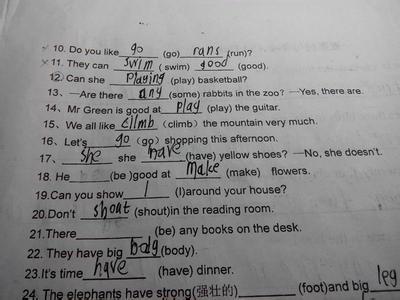非谓语动词和独立主格结构讲解大全
系统专题复习
虚拟语气系统复习(一)
非谓语动词系统复习(二)
主要章节内容:
第一章非谓语动词
一、非谓语动词专题要点
二、非谓语动词考纲要求
三、非谓语动词教法指引
四、非谓语动词知识网络
(一)不定式和动名词作主语的区别
(二)不定式、动名词和分词作表语的区别
(三)不定式和动名词作宾语的区别
(四)不定式、现在分词和过去分词作定语的区别
(五)不定式和分词作状语的区别
(六)非谓语动词常考的其它结构
(七)非谓语动词中的有关句型
(八)非谓语动词的特殊结构
第二章独立主格结构
一、独立主格结构的概念
二、独立主格结构的功能
三、独立主格结构的形式
四、独立主格结构的举例
五、独立主格结构与分词短语作状语的异同
六、独立主格结构与独立成分的异同
七、非谓语动词独立主格结构
八、 with、without 引导的独立主格结构
九、独立主格结构的句法功能
一、非谓语动词专题要点
非谓语动词和独立主格结构主要用法如下:
1.动名词和动词不定式作主语、宾语;
2.只跟动名词作宾语的动词或动词短语;
3.只跟动词不定式作宾语的常见动词;
4.既可以跟动名词又可以跟动词不定式作宾语,且意义不同的动词或短语;
5.不定式、现在分词、过去分词作宾语补足语的区别;
6.不定式、现在分词、过去分词作定语时的区别;
7.不定式、现在分词、过去分词作状语时的区别;
8.动名词的复合结构在句中作状语;
9.there be 结构的两种非谓语形式;
10.独立主格结构在句中作状语;
11.with复合结构在句中作状语或定语。
http://blog.sina.com.cn/s/blog_53ca7b1b0100m1sb.html
二、非谓语动词考纲要求
非谓语动词包括不定式、动词-ing形式和过去分词三种形式。
动词的非谓语形式是中学英语语法的重点和难点,也是每年高考热点中的热点, 考纲要求掌握:
非谓语动词的时态和语态;他们在英语句子中的作用;
非谓语动词的基本用法和含义,非谓语动词在句子中可以充当多种句子成分,比如主语、宾语、宾语补足语、定语、状语、表语等;
掌握非谓语动词充当相同句子成分时的辨析;掌握非谓语动词在不同的语境、语义下的运用。
对于独立主格结构考纲要求掌握独立主格结构的构成方式;在句子中的作用以及with复合结构。
三、非谓语动词教法指引
非谓语动词包括不定式、v-ing形式和过去分词,是高中英语学习的难点,也是高考考查的重点。高中英语非谓语动词是一个重要考点,学生复习备考中要注意重点突出、训练得当,尤其是对以下要点的复习:
1.不定式、现在分词与过去分词的用法区别;
2.非谓语动词的主动式与被动式;
3.非谓语动词完成式的用法;
4.非谓语动词用作伴随状语;
5.非谓语动词用作目的状语;
6.非谓语动词用作结果状语;
7.非谓语动词用作宾语补足语;
8.非谓语动词的逻辑主语问题;
9.非谓语动词用作主语的问题;
10.“(be+)过去分词+介词”结构;
11.动名词的复合结构和there be结构的非谓语动词形式。
对于独立主格结构的复习,考生必须要理清它的构成方式和在句子中的作用以及与with复合结构和分词之间的辨析的关系。
四、非谓语动词知识网络
非谓语动词主要包括不定式、动名词和分词。为了区分这三种不同的非谓语动词的用法和含义,我们将分别从三种非谓语动词在句子中做主语、宾语、宾语补足语、定语、状语、表语以及一些特殊结构句型等角度来区分其用法和细微含义。
(一)不定式和动名词作主语的区别
(1)动名词作主语通常表示抽象动作;
而不定式作主语表示具体动作。
(2)动名词作主语时,通常用以表示一件已知的事或经验。
不定式短语通常用来表示一件未完成的事或目的。
(3)不定式做主语,一般用it当形式主语,把作主语的不定式短语后置。
It took me only five minutes to finish the job.
(二)不定式、动名词和分词作表语的区别
(1)不定式作表语
1)不定式作表语一般表示具体动作,特别是表示将来的动作。
2)如果主语是不定式(表示条件),表语也是不定式(表示结果)。
- Tosee is to believe.百闻不如一见。
- Towork means to earn a living.工作就是为了生活。
3)如果主语是以
aim, duty,hope, idea,happiness, job,plan, problem, purpose,thing,wish等为中心的名词,
或以what引导的名词性从句,不定式作表语是对主语起补充说明作用。
- His wish is to buy a luxurious car in the nearfuture.他的希望是在不远的将来买一辆豪华轿车。
- Themost important thing is to negotiate with them about the future ofthe country.
(2)动名词作表语:动名词作表语,表示抽象的一般性的行为。
- Ourwork is serving the people.我们的工作是为人民服务。
- Hishobby is collecting stamps.他的爱好是集邮。
(注)动名词作表语时与进行时态中的现在分词形式相同,但其所属结构迥异,进行时态说明动作是由主语完成的。动名词做表语,说明主语的性质或情况。
(3)分词作表语
分词做表语有两种情况,一种是现在分词做表语,一种是过去分词做表语,这两者区别是考试中经常考到的地方。一般来说,表示心理状态的动词如excite,interest等都是及物动词,汉语意思不是“激动”,“兴趣”,而是“使激动”、“使发生兴趣”,因而现在分词应该是“令人激动的”、“引起兴趣的”,过去分词则是“感到激动的”和“感到高兴的”。所以,凡表示“令人……的”都是-ing形式,凡是表示“感到……”都用-ed形式。换句话说,若人对……感兴趣,就是:
somebody is interested in...,若人/物本身有兴趣时,就是说:
sb./sth. is interesting.这类词常见的有:
interesting使人感到高兴--interested感到高兴的
exciting令人激动的--excited感到激动的
delighting令人高兴的--delighted感到高兴的
disappointing令人失望的--disappointed感到失望的
encouraging令人鼓舞的--encouraged感到鼓舞的
pleasing令人愉快的--pleased感到愉快的
puzzling令人费解的--puzzled感到费解的
satisfying令人满意的--satisfied感到满意的
surprising令人惊异的--surprised感到惊异的
worrying令人担心的--worried感到担心的
- Travelling isinteresting but tiring.旅行是有趣的,但是使人疲劳。
- Thepupils will get confused if they are made to learn toomuch.如果要学生学得太多,他们会感到糊涂的。
- Theargument is very convincing.他的论点很令人信服。
- They were veryexcited at the news.听到这个消息,他们非常激动。
http://blog.sina.com.cn/s/blog_53ca7b1b0100d6q2.html
(三)不定式和动名词作宾语的区别
英语中大多数动词既可跟不定式,也可跟动名词作直接宾语,但有些动词要求:
(1)不定式做宾语和宾语补足语
1)下面的
48个动词要求不定式做宾语
【口诀记忆】
决心学会想希望,拒绝设法愿假装,
主动答应选计划,同意请求帮一帮,
愿望似乎就没有,碰巧承担常努力。
- attempt企图prepare准备
- afford负担得起demand要求
- long渴望arrange安排
- destine注定manage设法
- expect期望appear似乎,显得
- seem似乎,seek找,寻觅
- determine决定decide 决定
- hate憎恨,厌恶pretend假装
- ask问,need需要(want,require)
- agree同意,desire 愿望,
- swear宣誓refuse拒绝
- volunteer志愿wish希望
- offer提供beg请求,
- fail不能,plan计划
- bother扰乱,happen碰巧
- learn学习 choose选择
- hesitate犹豫claim要求
- hope希望promise承诺
- undertake承接intend想要
- refuse拒绝propose提议,
Heoffer to help me with myEnglish.
Hedecided to speak thetruth.他决定要说实话。
They hope to meetsoon.他们希望不久见面。
Sherefusedtocorrect my compositions.她拒绝批改我的作文。
He promised to buy a new cellphone for me as abirthday present.他答应给我买一部新手机作为生日礼物。
2)下面的动词(55)要求不定式做宾补:
动词+宾语+动词不定式
- ask要求,邀请
- get请,得到
- prompt促使
- allow允许
- forbid禁止
- prefer喜欢,宁愿
- announce宣布
- force强迫
- press迫使
- bride收买
- enable使能够
- inspire鼓舞
- request请求
- assist协助
- hate憎恶表示
- advise劝告
- help帮助
- recommend劝告,推荐
- bear容忍
- remind提醒
- beg请求
- report报告
- compel强迫
- invite吸引,邀请,
- command命令
- intend想要,企图
- show显示
- drive驱赶
- mean意欲,打算
- train训练
- cause引起
- instruct指示
- require要求
- deserve应受
- leave使,让
- tell告诉
- direct指导
- like喜欢
- tempt劝诱
- entitle有资格
- order命令
- warn告诫
- enable使能够
- need需要
- urge激励,力说
- encourage鼓励
- oblige不得不
- lead引起,使得
- teach教
- permit允许
- wish希望
- want想要
(2)有少数动词只能用动名词作宾语
【口诀记忆】
考虑建议盼原谅,避免错过继续练,
否认完成就欣赏,禁止想象才冒险,
不禁介意准逃亡
最常考的20个动词+doing
- dislike不喜欢,讨厌appreciate感激,欣赏
- avoid避免enjoy享有,喜爱
- can'thelp不禁can't stand受不了
- delay延迟escape逃跑,逃
- consider考虑mind 介意
- finish完成miss错过
- suggest建议risk冒险
- imagine设想excuse借口
- practise 实行,实践prevent阻止
- keep保持give up放弃
- postpone延迟,延期pardon原谅,饶恕
acknowledge承认cease 停止
mention说到,讲到advocate:提倡,主张
admit承认tolerate忍受
complete完成confess坦白
endure忍受contemplate细想
bear忍受defer拖延
envy嫉妒deny否认
favor造成,偏爱
resist抵抗,阻止
forgive原谅permit 允许
resume恢复involve卷入,包含
hate讨厌quit放弃停止
Iappreciate having been given the opportunity to study abroad twoyears ago.我很感激两年前给我出国学习的机会。
补充: 非谓语(动名词)作宾语四种情况
(3)有些动词后使用动名词和动词不定式作宾语的差别
【口诀记忆】
想起忘记常后悔
rememberregret trymean
can'thelpforgetstopgoon
1)forget to do忘记要去做某事(此事未做)
forgetdoing忘记做过某事(此事已做过或已发生)
2)stop to do停止、中断(某件事),目的是去做另一件事;stop doing 停止正在或经常做的事
3)remember to do记住去做某事(未做);
remember doing记得做过某事(已做)
4)regret to do对要做的事遗憾;
regret doing对做过的事遗憾、后悔
5)try todo努力、企图做某事;
try doing试验、试一试某种办法
6)mean to do打算,有意要;
mean doing意味着
7)goon to do 继而(去做另外一件事情);
go on doing 继续(原先没有做完的事情);
8)like/love/hate/ prefer +to do 表示具体行为;+doing sth表示抽象、倾向概念
(注) 如果这些动词前有should一词,其后宾语只跟不定式,不能跟动名词。例如:
Ishould like to see him tomorrow.
9)need, want, require,deserve
+动名词表被动意义;
+不定式被动态表示“要(修、清理等)”意思。
Don't you rememberseeing the man before?你不记得以前见过那个人吗?
Youmust remember to leave tomorrow.你可要记着是明天动身。
Idon't regret telling her what Ithought.我不后悔给她讲过我的想法。(已讲过)
Iregret to have to do this, but I have nochoice.我很遗憾必须这样去做,我实在没办法。(未做但要做)
Youmust try to be more careful.你可要多加小心。
Let's try doing thework in some other way.让我们试一试用另外一种办法来做这工作。
Ididn't mean to hurt your feeling.我没想要伤害你的感情。
Thisillness will mean (your) going tohospital.得了这种病(你)就要进医院。
(四)不定式、现在分词和过去分词作定语的区别
(1)不定式作定语
1)不定式与其所修饰的名词可能是主谓关系。
Hewas the last one to leave schoolyesterday.昨天他是最后一个离开教室的。
Thetrain to arrive was from London.将要到站的火车是从伦敦开来的。
2)不定式与其所修饰的名词可能是动宾关系
Gethim something to eat.给他拿点儿东西吃。
Shehas a lot of work to do in themorning.早上他有很多工作要做。
3)不及物动词构成的不定式做定语,要加上适当的介词和被修饰的名词形成逻辑上的动宾关系,这里的介词不能省去。
Ineed a pen to write with.我需要一支笔写字。
There is nothing toworry about.没有什么值得发愁的。
4)不定式修饰一些表示方向、原因、时间、机会、权利等抽象名词如:
ability能力,本领
drive赶,驾驶
movement运动,活动
ambition抱负,野心
effort努力,尝试
need需要,需求
campaign战役,运动
failure失败,不及格
opportunity机会
chance机会
promise许诺,希望
courage勇气
intention意向,意图
reason理由,原因
decision决定
method方法,方式
determination决心,决定
motive动机,目的
struggle奋斗,努力,
tendency倾向,趋势
wish希望,愿望,祝愿
5)被修饰的名词前有序数词、形容词最高级或next,second, last, only和not a,the等限定词时候,只能用不定式作定语。
6)不定代词something,nothing, little, much, a lot 等习惯上用不定式做定语。
Johnwill do anything but work on afarm.除了农活,约翰什么都愿意干。
7)如果其动词要求用不定式做宾语,或者其形容词要求不定式做补语,则相应的名词一般用不定式做定语。如:
tendto do---tendency to do;
decide to do =decision to do;
becurious to do = curiosity to do
(2)分词作定语
分词作定语时有下面几个特点:
1)现在分词表示主动意义←◇→过去分词一般表示被动含意。
2)现在分词表示正在进行←◇→过去分词表示状态或做完(完成)的事。
- Herushed into the burninghouse.他冲进了正在燃烧着的房子。
- Thechild standing over there is mybrother.站在那儿的男孩子是我弟弟。
- Theroom facing south is ourclassroom.朝南的房间是我们的教室。
- One way totruly understand an idea is to have hands-on practice, and to applyconcepts learned in atextbook.
- Have you got yourrepaired watch ? 你拿到那个修好的表了吗?
- Heis an advanced teacher.他是个先进教师。
3)下列不及物动词也以过去分词形式做定语或表语,但不具有被动意义,这点要注意:
(3)不定式和分词作定语时的时间关系
一般来说,不定式所表示的动作发生在谓语动词所表示的动作之后;
现在分词所表示的动作与谓语动词所表示的动作同时发生;
过去分词表示的动作发生在谓语动词所表示的动作之前。例如:
- asking questions as areaction to somethingread or discussed
- Who are the intended reader ofthepassage?
- Doyou want to see the doctor to be sentfor from Beijing?你要见那位将从北京请来的医生吗?
- Doyou want to see the doctor working on thecase report in theoffice?你要见那位正在办公室里写病历的医生吗?
- Do you wantto see the doctor invited byus?你要见那位邀请的医生吗?
(五)不定式和分词作状语的区别
(1)现在分词与过去分词作状语的区别。
现在分词做状语与过去分词做状语的最主要区别在于两者与所修饰的主语的主动与被动关系的区别。
1)现在分词作状语时,现在分词的动作就是句子主语的动作,它们之间的关系是主动关系。
He went out shuttingthe door behind him.他出去后将门随手关上。
Not knowing what to do, he went to his parents forhelp.由于不知如何办是好,他去找父母帮忙。
2)过去分词作状语时,过去分词表示的动作是句子主语承受的动作,它们之间的关系是被动关系。
When learned early on, these skills can be usedthroughout their college education.
Given more attention, the trees could have grownbetter.如果对这些树多关心一些,它们本来会长得更好。
Faced withdifficulties, we must try to overcomethem.在遇到困难的时候,我们必须设法克服。
(2)动词不定式和分词作状语的区别
1)分词作状语一般表示伴随,而不定式常常表示目的。
Theystood by the roadside talking about theplan.他们站在路边谈论着这个计划。(伴随)
Theystoodby the roadside to talk about theplan.他们站在路边为的是谈论这个计划。(目的)
2)分词作状语放在句子开头,除表示原因之外有时表示时间或条件。
动词不定式作状语时,除了表示目的以外,还表示结果或原因。
(3)下面一些句型是不定式做状语时候应该注意的:
1)not/never too…to,
too…not to ,
but/only too… to,
too ready/eager to 表示肯定意义
连接参考:英语中否定形式表示肯定意义的句型总结
2)做结果状语的不定式只能出现在句子的末尾,常见的不定式动词有:
find, hear, see, be told
form, give, make, produce 等。
Iawoke to find my truck gone. 我醒来发现卡车不见了。
He searched the room only to find nothing.他搜索了房间,没发现什么
3)不定式做状语时,其逻辑主语一般为句子的主语,否则用for引出主语。
(六)非谓语动词常考的其它结构
(1)疑问词+不定式结构
疑问词who,what,which,when,where和how后加不定式可构成一种特殊的不定式短语。它在句中可以用作主语、宾语、表语和双重宾语。如:
注:
1)有时疑问词前可用介词,如:
Ihave no idea of how to do it.我不知道如何做此事。
2)动词know 后面不能直接跟不定式作宾语,只能跟疑问词(如:how,what)+不定式:
While still ayoung boy, Tom knew how to play the piano well and as he grewolder, he wrote operas, the most famous of which isCarmen.
(2)介词except和but作“只有…,只能…”讲时跟不定式结构(but与不带to的不定式连用)。
Whenthe streets are full of melting snow, you cannot help but get yourshoes wet.
(3)不带to的不定式
1)在表示生理感觉的动词后的不定式不带to。这类词有:
see看见
watch注视
notice注意
lookat看
observe注意到,看到
feel觉得
hear听到
overhear听到
listento听
Onseeing the young child fall into the lake,Eric jumped into thewater to save her.
2)另一类是某些使役动词,如make, let,have等。如:
(注):
1)上述感觉动词与使役动词转换为被动结构时.其后的不定式一般需带to,如:
2)在动词find与help之后,不定式可带to亦可不带to,如:
3)在do nothing/anything/everythingbut(except)结构中,but(except)不带to。例如:
(但是,也有这么一种惯例:如果谓语动词不是“donothing,anything,everything”,那么but (except)所跟的不定式则仍须带to。
(4)不定式与动名词的逻辑主语和分词独立结构
1)不定式的逻辑主语为:for +名词(或代词宾格)+ 不定式。例如:
2)动名词的逻辑主语为:
①人称代词的所有格+动名词;
②名词's+动名词。例如:
3)某些形容词,如:careless等后不定式后可以加of来引导出其逻辑主语。
(注)在表示人物性格、特性等的形容词后面,常用of引出不定式的逻辑主语。例如:
这类词主要有:
brave, courageous,careful, careless, clever, wise, foolish, silly, stupid, good,nice, kind, thoughtful, considerate, greedy, generous, honest,modest, polite, rude, cruel ,selfish, wicked adj.坏的, 邪恶的, 缺德的, 不道德的, 恶劣的, 刻毒的,淘气的,
wrong等
间或也可用for + thereto be表示(而且there后面的不定式只能是to be)。
(七)非谓语动词中的有关句型
(1)动名词作主语的句型
1)Doing...+ v.
Reading is anart.阅读是门艺术。
Seeing isbelieving.眼见为实。
比较:To choose time is tosave time.
2) It is + no use, no good (fun, a great pleasure, a waste of time,a bore...)等名词+doing sth.
3)It is + useless (nice, good等形容词)+ doing sth.
(八)非谓语动词的特殊结构
有些非谓语形式已成为固定用语,用来表示说话人对说话内容所特的态度。
1)现在分词的独立结构
judging from / by…,
generallyspeaking,
strictly speaking;
2)不定式的独立结构
to tell you the truth,
tomake things worse,
tobegin / start with
3)动词原形:
Believe it or not(信不信由你)
4)作连词的分词
considering(考虑到,就…而言),providing / provided …假如,
supposing假如
这些词用来表示条件的连词,后接that从句。
第二章 独立主格结构
http://blog.sina.com.cn/s/blog_53ca7b1b0100m1sb.html
一、独立主格结构的概念:
“独立主格结构”是由名词或代词作为逻辑主语,加上分词、形容词、副词、动词不定式或介词短语作为逻辑谓语构成。这种结构在形式上与主句没有关系,通常称为“独立主格结构”。
二、独立主格结构的功能:
“独立主格结构”实质就是带有自己主语的非限定状语从句。众所周知非限定性从句通常以主句的某一成分作为自己的逻辑主语,从而依附于主句。而有些非限定性从句和无动词从句带有自己的主语,在结构上与主句不发生关系,因此成为独立主格结构。其实,虽然叫做独立主格结构,并不是真正的独立,它还是一种从属分句,在句中有多种作用。如:表原因、表条件、表方式、表伴随、表时间等,在句中通常起状语作用。
三、独立主格结构的形式:
独立主格结构在形式上有两部分组成:第一部分有名词或代词担任,第二部分由分词、动词不定式、形容词、副词、或介词短语担任。按其结构形式分为:
五、独立主格结构与分词短语作状语的异同:
1、独立主格结构与分词短语都可以转化成状语从句。但是,
六、独立主格结构与独立成分的异同:
1、有的分词短语可以独立存在,在句子中没有逻辑上的主语,实际上已经成了习惯短语。这些短语有:
2、有些固定短语是带to的不定式,表明说话人的立场和态度,在句中作独立成分。这些短语有:
七、非谓语动词独立主格结构
在独立主格结构中,非谓语动词和它前面的名词或代词存在着逻辑上的主谓关系。
1)Such an able man to help you,you will surely succeed sooner orlater.有这么能干的人来帮你, 你迟早一定会成功的。(such an able man和 to help you之间存在着主谓关系)
= Since such an able man will help you, you willsurely succeed sooner or later.
2)He seating himself at the desk, hismother began to tell him a story.他在书桌旁坐好后,他母亲开始给他讲故事。(seatinghimself at the desk拥有了自己的逻辑主语he,注意是“主格”)
= When he seated himself atthe desk, his mother began to tell him a story.
3)The key to the bike lost, hehad to walk to school.由于丢了自行车钥匙,他只好步行去学校。(lost 的逻辑主语是the key,lost也可以用完成式having been lost)
= Because the key to the bike had been lost, hehad to walk to school.
(一)不定式“独立主格结构”一般表示将来。
在“逻辑主语+动词不定式”结构中,动词不定式和它前面的名词或代词存在着逻辑上的主谓关系。这种结构也可用一个从句或并列分句来表达。动词不定式用主动的形式。
在独立主格结构中,动词不定式和它前面的名词或代词存在着逻辑上的主谓关系。
1、His mother to come tonight,he is busy preparing thedinner.他母亲今晚要来,他正在忙着准备饭菜。(= As his mother is to come tonight, he is busypreparing the dinner.)
2、——Will you go to theconcert tonight你今晚去听音乐会吗?
——Sorry. So many exercise-booksto check, I really can't afford anytime.对不起,有这多的作业要批,我真的抽不出时间。
(=Because I shall check so many exercise-bookstonight ,I really can't afford anytime.)
3、The four of us agreed on adivision of labour , each to translate a quarter of thebook.我们四人同意分工干,每人翻译全书的四分之一。
(=The four ofus agreed on a division of labour and each is to translate aquarter of the book.)
4、Many trees,flowers, and grassto be planted, our newly-builtschool will look even more beautiful.种上许多的树,花和草后,我们新建的学校将看上去更美。
(=If many trees,flowers, andgrass are planted, our newly-built school will look even morebeautiful.)
(二)-ing形式“独立主格结构”一般表示正在进行。
动词的-ing形式作状语时,其逻辑主语一般应与句子的主语保持一致。
1、Being ill, he went home. 由于生病,他回家了。(= As he wasvery ill, he went home.)
2、Seating himself at the desk, he began to read amagazine.在课桌旁坐好后,他开始看杂志。(= When he had seated himself at the desk,he began to read a magazine.)
1. 表示时间的-ing形式作“独立主格结构”
1)Everyonebeing ready, the teacher began his class.每个人都准备好后,老师开始上课。(相当于一个时间状语从句When everyonewasready)。
特别提示:
注意:有时being ready中的being r可以省略。例如:
So many students being absent, the meeting had to be putoff. so many studnets 与beingabsent之间的逻辑上的主谓关系,表状态。
His homework having been done, Tom went to sleep.His homework 与having been done,也是逻辑上的主谓关系,having beendone表示已经被完成的动作。
在,“独立结构”中的being或 having been 有时可以省去,这样就成了with +adj.或with+过去分词。
2)The chairman began the meeting , everyone(being) seated.每个人坐好后,主席开始开会。(相当于一个时间状语从句after everyone wasseated)
2.表示原因的-ing形式作“独立主格结构”
1)The boy leading the way, we had no trouble finding the strangecave. 由那个男孩带路,我们没有困难就找到了那奇怪的洞。(相当于一个原因状语从句Because the boy led theway)
2)Many eyes watching him, hefelt a bit nervous. 许多眼睛看着他,他感到有点儿紧张。(相当于一个原因状语从句As many eyes werewatching him)
必背:
3.含有being的独立主格结构。
1)It being National Day today,the streets are very crowded.今天是国庆节,街上很拥挤。
= As it is National Day today,the streets are very crowded.
2)Therebeing no further business to discuss, we all went home.没有别的事可讨论,我们都回家了。
= As there was no further business to discuss, weall went home.
(三) 表示条件的-ing形式作“独立主格结构”
1)Time permitting, we willhave a picnic next week.时间允许的话,我们下星期将进行一次野炊。(相当于一个条件状语从句If timepermits)
2)My health allowing, I willwork far into the night.我的健康许可的话,我愿工作到深夜。(相当于一个条件状语从句If my healthallows)
(四)表示方式的-ing形式作“独立主格结构”
1)The students are walking inthe school happily, each wearing a card in front of hischest.学生们快乐地在学校里走着,每个人胸前都带着一张卡。(相当于一个并列分句and each wears a card infront of his chest)
2)The boy lay on the grass,his eyes looking at the sky.男孩躺在草地上,眼睛看着天空。(相当于一个并列分句and his eyeswere looking at the sky)
(五)-ed形式“独立主格结构”
与逻辑主语+动词的-ing形式一样,如果-ed形式的逻辑主语和句子的主语不一致的话,就需要用-ed形式的独立主格结构。
1、The book written in simpleEnglish, English beginners were able to readit.该书是用简单英语写的,英语初学者也能看懂。
= As the book was written insimple English,English beginners were able to read it.
2、The workers worked stillharder, their living conditions greatlyimproved.由于工人们的生活条件大大提高,他们工作得更起劲了。
= As their living conditionswere greatly improved, the workers worked still harder.
3、He was listening attentivelyin class, his eyes fixed on the blackboard.他上课专心听讲,眼睛紧盯着黑板。
= He was listening attentively in class, andhis eyes were fixed on the blackboard.
特别提醒:
1、在“with+名词(代词)+现在分词/过去分词”结构中,当表人体部位的词做逻辑主语时,及物动词用过去分词,不及物动词用现在分词。
例1:
He stood there, his hand raised.
= He stood there, with his handraised.
例2:
The murderwas brought in, with his hands ___ behind his back。
A. beingtiedB. having tied
C. to be tied D.tied
答案D. with+名词(代词)+分词+介词短语结构。当分词表示伴随状况时,其主语常常用with来引导。由于本句中名词"手"与分词"绑"是被动关系,因此用过去分词,选D.
例3:
He lay there, his teeth set, his hand clenched, and hiseyes looking straight up.
例4:The boy said,turningto the man,his eyes opened wide and his handraised.(独立主格结构,表示伴随状况或行为方式,作状语)
例5:
He looked at me,with his eyebrows raised.(2011广州一模语法填空)
辅助理解:There were a lot of eyebrows raised at the news of the minister'sdismissal.部长被免职的消息引起众人的惊讶。
2、当介词是in时,其前后的两个名词均不加任何成分(如物主代词或冠词),也不用复数。但 with的复合结构不受此限制
例6:
A robber burst into the room, knife in hand.
例7:
Then last night,I followed him here,and climbed in,sword inhand.(名词+介词短语构成的独立主格结构,作状语,表示伴随情况)。
例8:
He lay there, his teeth set, his hand clenched,his eyes looking straight up.
例9:
The man laythere, his hands trembling. his hands与trembling之间是逻辑的主谓关系,且是主动的。
4、The taskcompleted, he had two months'leave.任务完成以后,他休了两个月的假。
(=When the task had been completed, he had two months'leave.)
比较:
动词不定式表示动作没有发生或即将发生,动词-ed形式表示动作已经结束,动词-ing形式往往表示动作正在进行。
1、The manager looksworried,many things to settle. 经理看上去很着急,有这么多的事情要处理。(事情还没有处理,而且是由经理本人来处理,用不定式to settle)
2、The manager looks relaxed,many things settled.许多事情已经处理好了,经理看上去很轻松。(事情已经处理好了,用动词-ed形式settled表示动作已经结束)
3、The food being cooked, the boy was watchingTV. 小孩一边做饭,一边看电视。(两个动作同时进行)
4、The food cooked, the boy went to bed.饭做好了,小孩去睡了。(两个动作有先后,饭已做好,小孩才去睡觉的
八、 with、without 引导的独立主格结构
介词with/without+宾语+宾语的补足语可以构成独立主格结构,上面的独立主格结构的几种情况在此结构中都能体现。
(一)with+名词代词+形容词
He doesn't like to sleep with the windows open. 他不喜欢开着窗子睡觉。
= He doesn't like to sleep when the windows are open.
He stood in the rain, with his clothes wet. 他站在雨中,衣服湿透了。
= He stood in the rain, and his clothes were wet.
注意:
在“with+名词代词+形容词”构成的独立主格结构中,也可用已形容词化的-ing形式或-ed形式。
With his sonso disappointing,the old man feltunhappy.由于儿子如此令人失望,老人感到很不快乐。
With his father well-known, the boy didn't want tostudy.父亲如此出名,儿子不想读书。
(二)with+名词代词+副词
Our schoollooks even more beautiful with all the lights on. 所有的灯都打开时,我们的学校看上去更美。
= Our school looks even morebeautiful if /when all the lights are on.
The boy waswalking, with his father ahead.父亲在前,小孩在后走着。
= The boy was walking and his father was ahead.
(三) with+名词代词+介词短语
- In fact, he often wears a T-shirtwith Sri Chinmoy's words on the back.
- He stood at the door, with a computer in hishand.
或He stood atthe door, computer in hand.他站在门口,手里拿着一部电脑。
= He stood at the door, and a computer was in hishand.
3. The boysat at the desk, with a pen in hismouth.
或:The boysat at the desk, pen inmouth.男孩坐在课桌前,嘴里衔着一支笔。
= The boysat at the desk, and he had a pen in his mouth.
(四)with+名词代词+动词的-ed形式
With his homework done, Peter went out to play. 作业做好了,彼得出去玩了。
= When his homework was done, Peter went out to play.
With the signal given, the train started.信号发出了,火车开始起动了。
= After the signal was given, the train started.
I wouldn't dare go home without the jobfinished.工作还没完成,我不敢回家。
= I wouldn't dare go home because the job was notfinished.
(五)with+名词代词+动词的-ing形式
The man feltvery happy with so many children sitting aroundhim.有这么多的孩子坐在他周围,那男子感到很高兴。
= The man felt very happy when he found so manychildren sitting around him.
The girl hidher box without anyone knowing where itwas.小女孩把盒子藏了起来,没有人知道它在哪里。
= The girl hid her box and noone knew where it was.
提示:
在with/without 的复合结构中,多数情况下with 能省略,但without不能省略。
Without aword more spoken, she left the meetingroom.她没再说什么话就离开了会议室。(without不能省略)
九、独立主格结构的句法功能
独立主格结构在句中除了能充当原因状语、时间状语、条件状语和伴随状语外,还能作定语。在形式上,“独立主格结构”可位于句首、句中或句尾,并通常用逗号与主句隔开。
(一)作状语
独立主格结构作状语,其功能相当于一个状语从句或并列分句。
1.表示时间
Night coming on, we put ourselves up in a small hotel.夜幕降临,我们在一家小旅馆住了下来。
(= Whennight came on, we put ourselves up in a small hotel.)
All the guests seated, they began their dinner.所有的客人就坐后,他们才开始吃饭。
(= When all the guests were seated, they begantheir dinner.)
With everything she needed bought, Grace took a taxi home.所需要的都买好后,格雷斯打的回家了。
(Aftereverything she needed was bought, Grace took a taxi home.)
2.表示原因
1)With alot of difficult problems to settle, the newly-elected president ishaving a hard time.有许多难题要解决,新当选的总统日子不好过。
(= As he has a lot of difficult problems to settle, thenewly-elected president is having a hard time.)
2)There being no means of transportation, he hadto walk home at midnight. 由于在半夜没有交通工具了,他只好步行回家。
(= As there was no means of transportation, he had to walk home atmidnight.)
3.表示条件
1) Weather permitting, we will hold our yearly sports meeting nextweek.如果天气允许的话,我们下星期将举行每年一次的运动会。
= If weather permits,we will hold our yearly sports meeting nextweek.)
2)All the work done, you can have a rest.所有工作做好后,你可以休息。
(=As long as all the work is done, you can have a rest.)
3)Everythingtaken into consideration, the plan seems to be more practical.如果从各方面考虑,你的计划似乎更实际些。
= If everything is taken into consideration, the plan seems to bemore practical.)
提示:
表示时间、原因、条件的独立主格结构一般放在句首,并且不能保留连词。
【误1】When class being over, thestudents left their classroom.
【正】Class (being) over, thestudents left their classroom. 下课了,学生都离开了教室。
【误2】The moon appearing and they continued their way.
【正】The moon appearing, they continued their way.月亮出来了,他们继续赶路。
4.表示伴随情况或补充说明
1)Thestrange man was walking down the street, with a stick in his hand.那个奇怪的男人在街上走着,手里拿着根手杖。
(= The strange man was walking down the street, and he carried astick in his hand.)
2)The murderer was brought in, with his handstied behind his back.杀人犯被带了进来,手被捆在背后。
(=The murderer was brought in, and his hands were tied behind hisback.)
3)Two hundred people died inthe accident, many of them children. 有两百人在事故中丧生,其中许多是儿童。
(=Two hundred people died inthe accident and many of them were children.)
5.作定语
独立主格结构作定语,其功能相当于一个定语从句。
1)He is the person with a lot of problems to besettled. (with 的复合结构作定语,修饰the student)
他就是有许多问题要解决的那个人。
= He is the person whohas a lot of problems to besettled.
比较:= He is the person who has a lot of problems tosettle.
2)You can use a large plastic bottle with its top cut off. (with的复合结构作定语,修饰bottle) 你可以使用一个颈被砍掉的大塑料瓶。
= You can use a large plastic bottle whose top was cut off.
3) He waswalking along the road without any street lights on its bothsides.
他走在一条两边没有路灯的马路上。 (without的复合结构作定语,修饰the road)
= He was walking along the road that didn’t haveany street lights on its both sides.
提示:
以上提到很多用连词连接的两个句子改为独立主格结构的情况。但是,不是所有用连词的地方都可以改为独立主格结构。
1) If you stand on the top ofthe mountain,the park looks more beautiful.如果你站在山顶上,公园看上去更美。(不要改为独立主格结构)
2) If youcheck your test paper carefully, some mistakes can beavoided.如果你仔细检查试卷的话,有些错误是可以避免的。(不要改为独立主格结构)
 爱华网
爱华网


